Chatbase vs Botpress: Which is the best AI chatbot platform?
This article breaks down and compares Chatbase and Botpress across key features like ease of use, customization, integrations, workflow automation, pricing, and customer feedback.
Use this guide to quickly understand the strengths and trade-offs of each AI chatbot platform, so you can determine which one best suits your needs.
Let’s go 👇
Chatbase vs Botpress: Overview
| Factor | Chatbase | Botpress |
|---|---|---|
| Public reviews | 4.6 ⭐ (G2), 4.5 ⭐ (Capterra) | 4.3 ⭐ (G2), 4.4 ⭐ (Capterra) |
| Our rating | 8.5/10 ⭐ | 8.5/10 ⭐ |
| Core purpose | No-code platform to build, train, and deploy custom AI chatbots with your data for websites and support. | Comprehensive API-centric chatbot builder enabling custom AI bots with conversational flows and workflow automation. |
| Best for | Businesses wanting fast, no-code GPT-powered chatbots for websites and support with minimal technical effort. | Developers/enterprises who seek deep customization, workflow automation, and self-hosting options. |
| Typical use cases | Customer support, website FAQs, lead capture, knowledge base automation, onboarding bots. | Complex conversational assistants, workflow bots, enterprise helpdesks, call center automation, multilingual bots. |
| Hosted vs self-hosted? | Hosted (SaaS only) | Both hosted (cloud) and self-hosted (open source/on-premises) |
| Open Source? | No | Yes (core Botpress SDK and platform) |
| Pricing model | Subscription: Usage-based tiers | Cloud: Subscription; Self-hosted: Free (OSS); Enterprise: Custom |
| Free plan? | Yes (limited messages, users, and bots) | Yes (open source, with limits for cloud version) |
| Customization level | Basic: Customize bot responses, embedding, and data sources. Some white-labeling at higher tiers. No custom code. | Advanced: Full workflow editing, intents/entities, API/webhook integrations, custom code, NLP config. |
| Ease of use | Very easy (no coding, drag-and-drop, most users live within 10 minutes). | Steep learning curve for non-developers, visual flow editor available, detailed documentation. |
| LLM integrations | GPT-3.5 & GPT-4 (OpenAI), Google PaLM (at higher tiers) | Any OpenAI API LLM (GPT-3/4), Google Vertex AI, Cohere, Hugging Face, Azure AI |
| Other integrations | Zapier, Slack, Whatsapp, Messenger, web chat widget; custom integrations via API webhook (limited) | Native: Facebook, Slack, Web, Twilio, Teams, WhatsApp, Voice (Twilio), APIs, Databases, SSO, robust plugin marketplace |
| Workflow capabilities | Simple Q&A flows, custom action triggers, basic rerouting, lacks deep conversational logic | Advanced workflow automation: flow builder, state management, triggers, conditional logic, rich actions |
| Deployment options | Web widget, iframe, API, major website builders, WordPress | Web, mobile, in-app, on-premises server, cloud, API, messaging platforms |
| Team collaboration | Multi-user (at higher tiers), simple role-based access, basic analytics | Multi-user project roles, granular permissions, team analytics, environments (dev/stage/prod) |
| Pros |
✅ Super easy setup ✅ No code needed ✅ Website widget/iframe support ✅ Fast training on custom data ✅ Decent analytics, white-label at higher tiers |
✅ Advanced customization ✅ Full self-hosting support ✅ Rich plugin/integration library ✅ Powerful workflow automation ✅ Open source/enterprise ready |
| Cons |
❌ Not open source ❌ No self-hosted option ❌ Limited advanced integration ❌ Basic workflow logic only ❌ Scaling costs can be high for usage |
❌ Requires technical skills ❌ Steeper learning curve ❌ Some features gated in cloud ❌ UI can be complex for beginners |
| Why choose it? | 👉 Best if you need a quick, no-code website chatbot that works out-of-the-box with your data and minimal setup. | 👉 Best for technical teams needing highly customizable, scalable bots with flexible deployment, advanced workflows, and full data control. |
Should you consider Big Sur AI instead?
Here's why:
Launch in minutes, not weeks
Big Sur AI is fully pre-built—just sign up, connect your docs or website, and your AI support assistant is live. There’s no setup of flows, model tuning, or API wrangling. Use cases: onboarding support, instant customer Q&A, and appointment bots ready the same day you sign up.
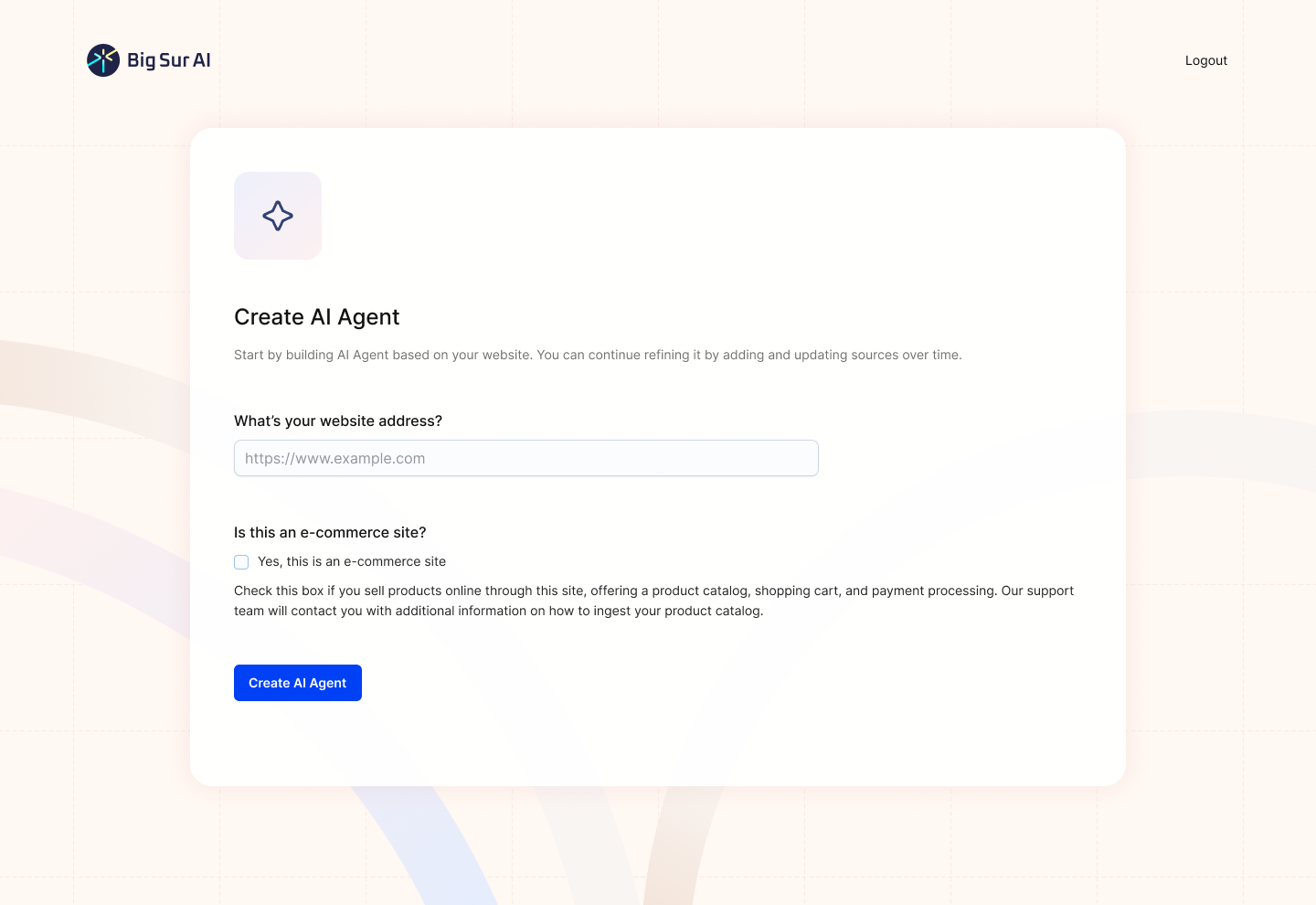
No maintenance headaches
With Big Sur AI, there's no need to manage platform updates, monitor hosting, or patch security issues. For example, if you’re running a small SaaS or e-commerce store, you won’t lose time on model retraining or troubleshooting integration breakages—the bot always works and adapts in the background.
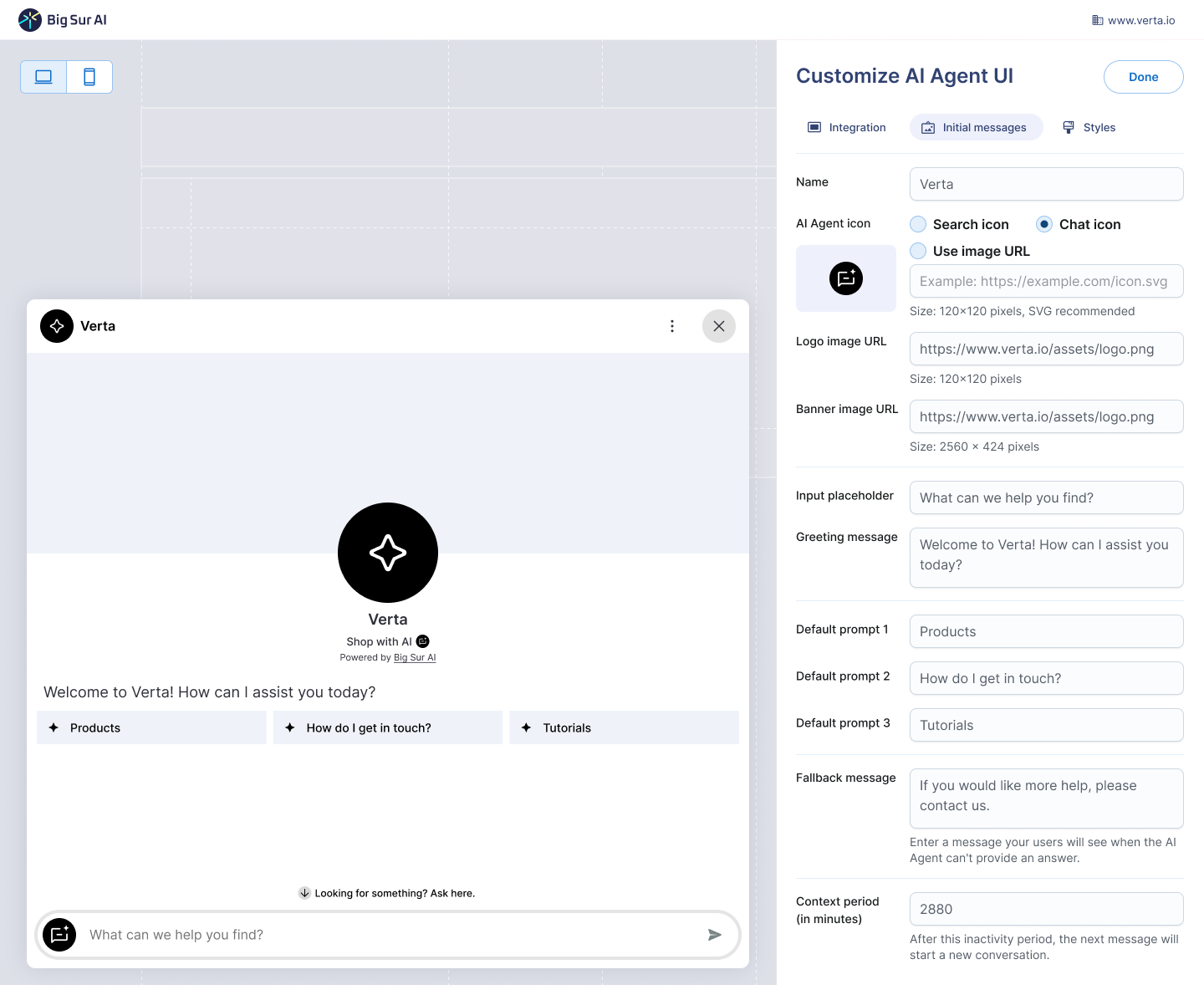
Everything included, truly end-to-end
Big Sur AI bundles training, analytics, omnichannel deployment, and user feedback out-of-the-box. This means you can monitor support quality, gather customer insights, and roll out to chat, email or social instantly, instead of cobbling together plugins as with Botpress or Zapier workflows in Chatbase.
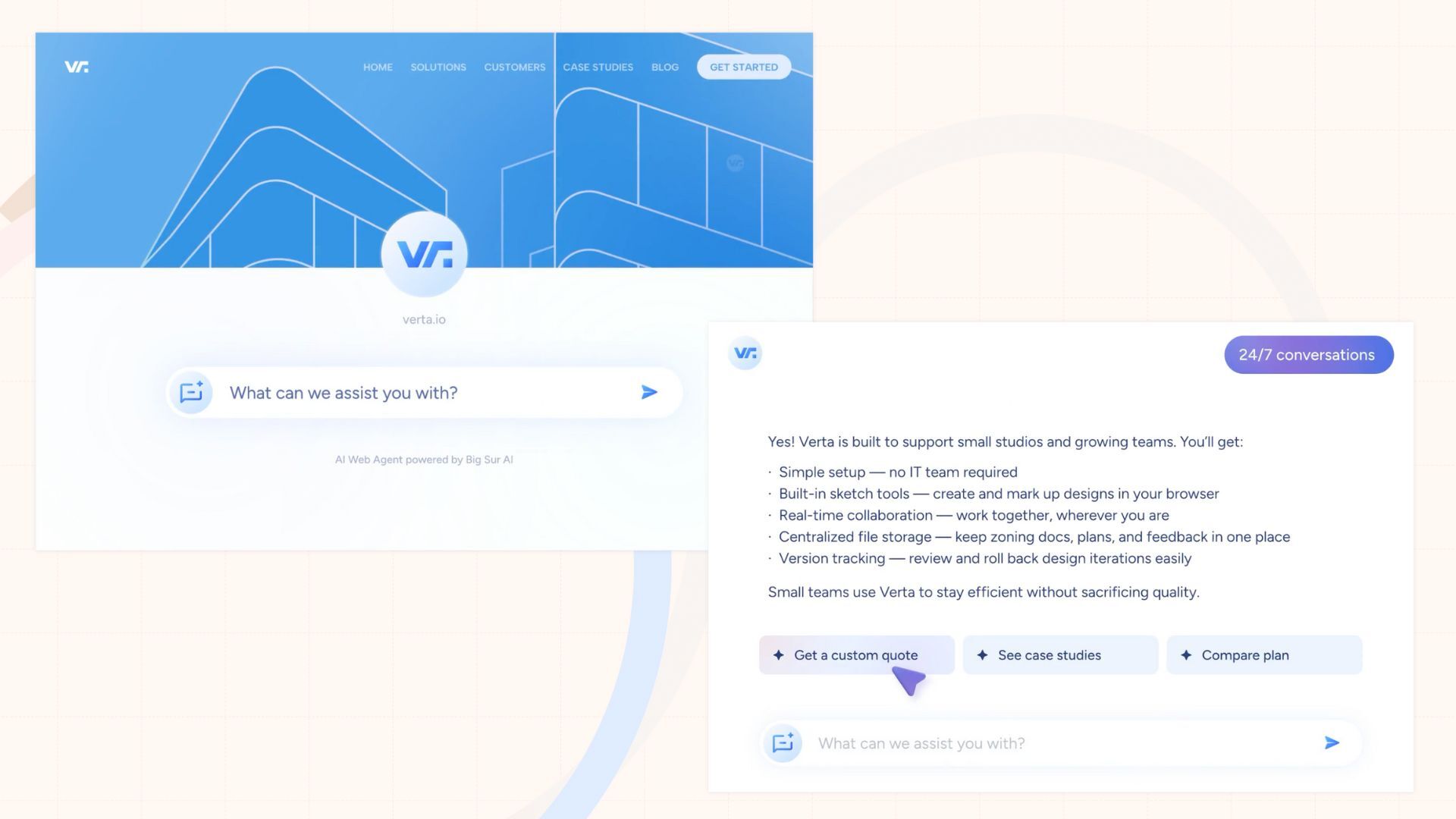
Built for the business problems you have now
Instead of building from scratch, Big Sur AI comes with proven use case templates—like product support, lead qualification, and HR self-service. A small marketing team can launch a lead capture bot or an HR team can get an onboarding helper with zero technical resource or trial-and-error configuration.
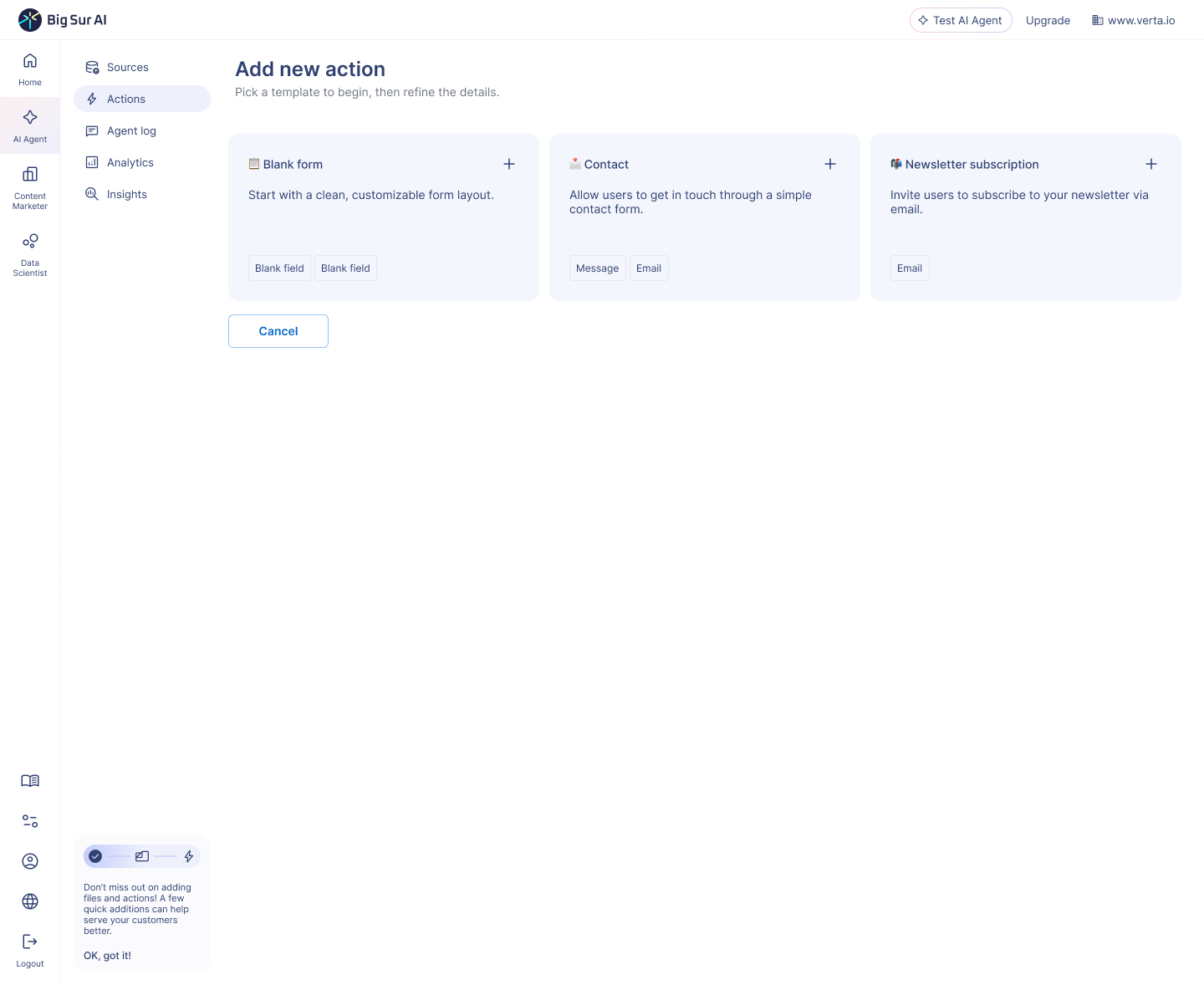
Botpress vs Chatbase: How do their features compare?
Chatbase is faster for uploading and converting knowledge bases
If you have a large PDF library, online documentation, or published articles you want to instantly turn into a chatbot, Chatbase makes the process simple and fast. It allows you to upload files, paste URLs, or import text, and automatically converts these into a knowledge base for your chatbot within minutes—no technical setup required. For example, uploading a 200-page product manual is as straightforward as drag-and-drop, and the chatbot becomes immediately equipped to answer in-depth questions based on that content.
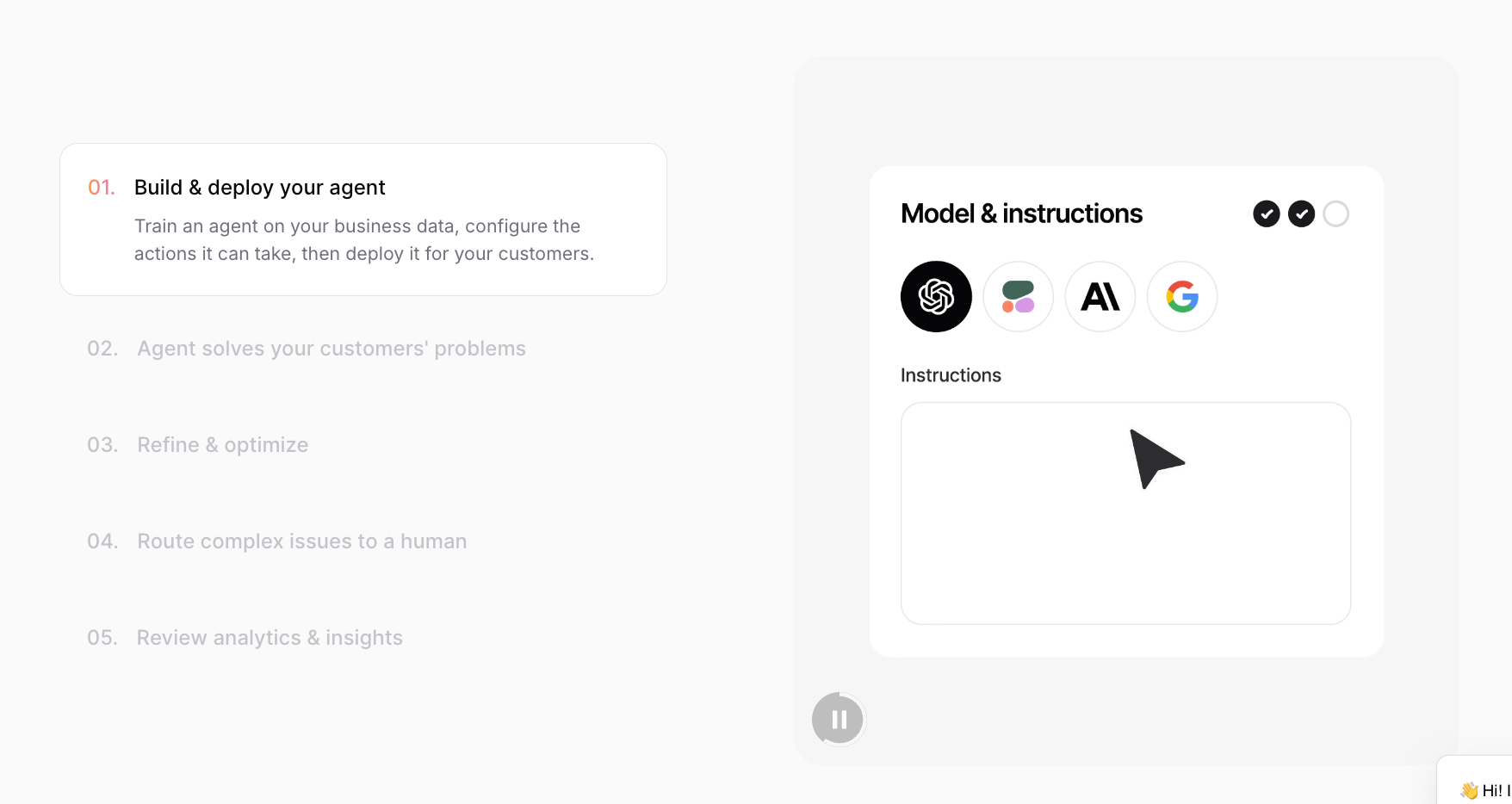
Botpress has richer multi-channel deployment options
Botpress makes it easier to deploy your bots beyond just your website. Out of the box, Botpress supports direct deployment to popular messaging platforms including WhatsApp, Facebook Messenger, Microsoft Teams, and Slack, as well as custom channels through its SDKs. This is especially valuable if your customer support needs to be omnichannel or if you want sales or onboarding bots within apps your customers already use.
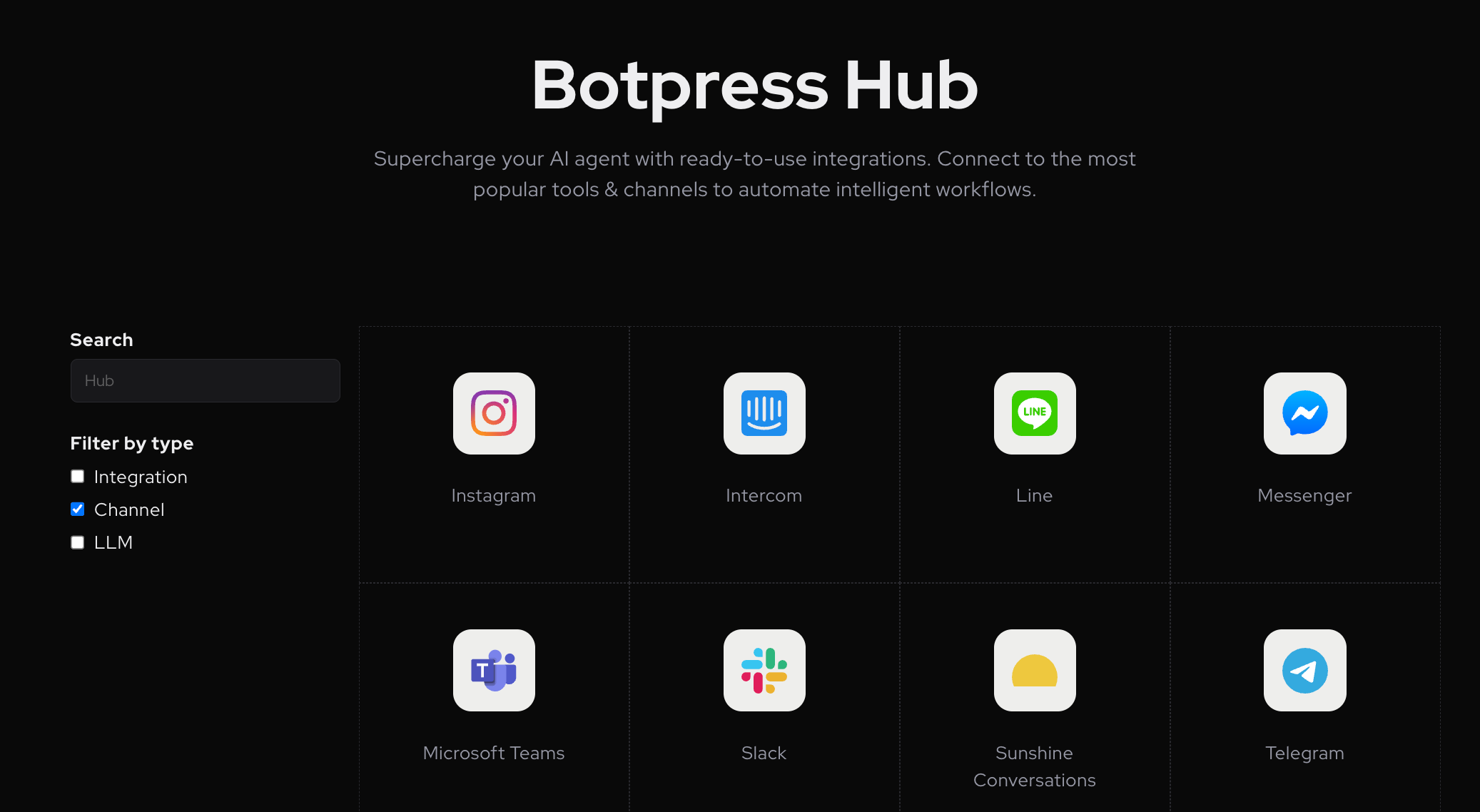
Chatbase’s conversational AI is more “plug-and-play”
One of Chatbase’s main selling points is that you can create a highly conversational, context-aware chatbot with almost zero setup. The AI is tuned to give accurate, natural responses from your content, so you don’t need to manually craft dialog flows, set up intents, or configure conversation logic. For businesses without dedicated development resources, this means you can go live in under 10 minutes, and the bot will handle nuance in queries that simple keyword-based bots often miss.
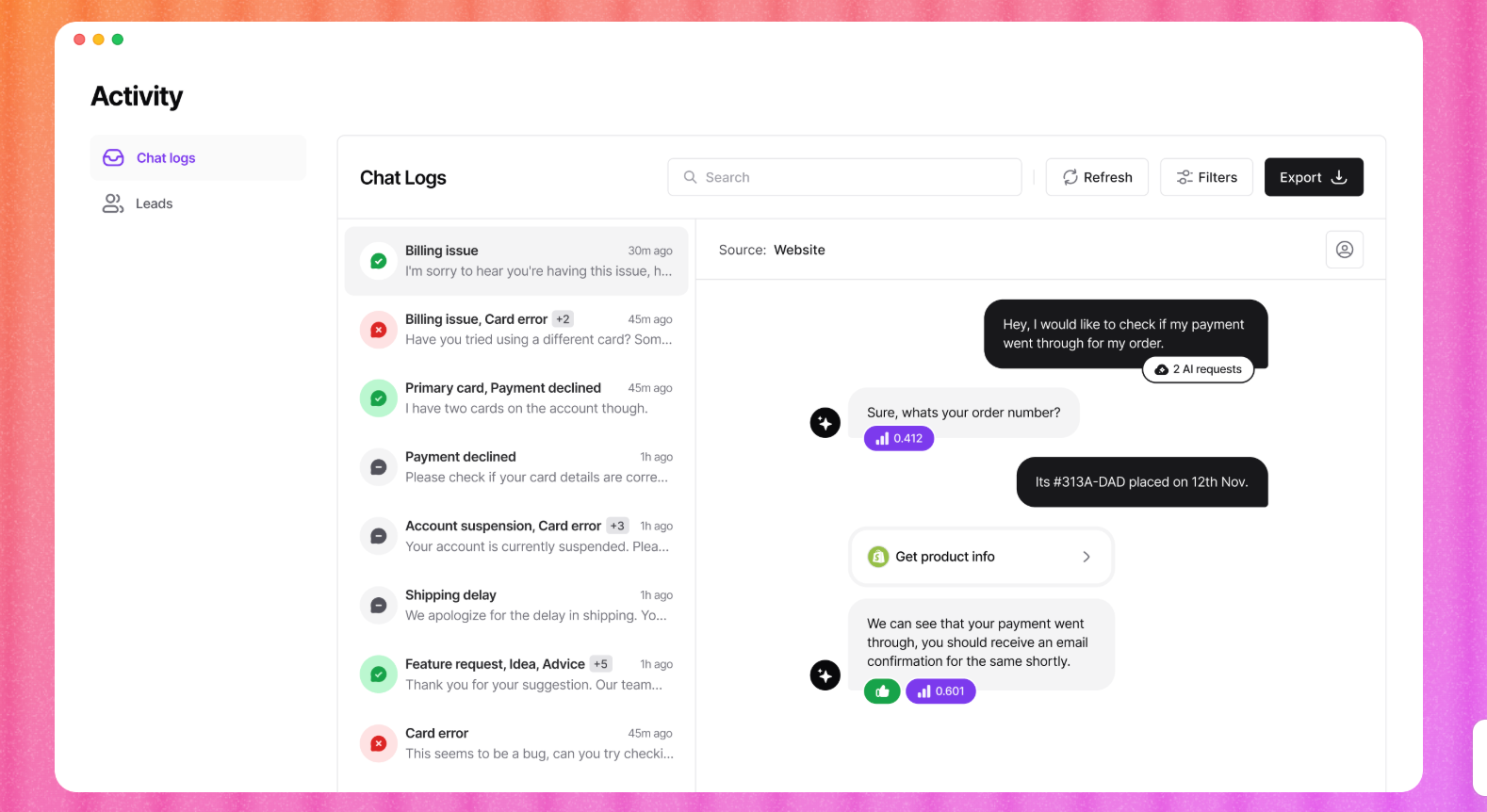
Botpress enables more advanced customization with flows and actions
Where Chatbase is a “ready out-of-the-box” tool, Botpress shines for those who want granular control. Botpress uses a visual flow builder and scripting engine to let you design complex workflows, conditional routing, API calls, and dynamic actions (like booking meetings or running backend automations). For example, an e-commerce company could build a bot that collects order details, checks inventory in a live system, and handles shipping updates—all from one conversational flow.
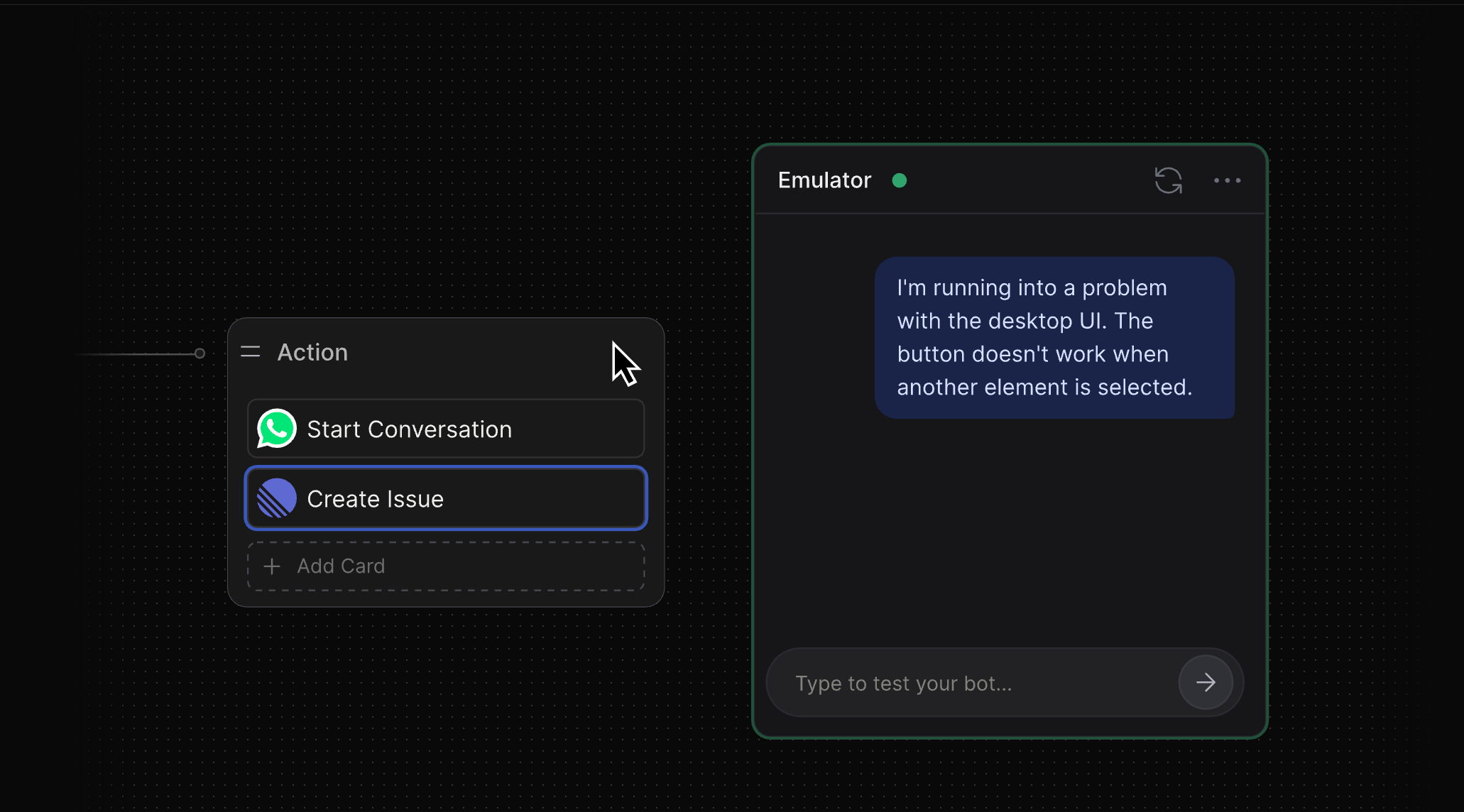
Chatbase integrates analytics and feedback collection natively
Chatbase includes built-in analytics showing chatbot performance—like total conversations, fallback rates (when the bot can’t answer), and popular queries—without external plugins. It also lets you prompt users for feedback at the end of an interaction, so you can quickly spot knowledge gaps or improve answers. For many businesses, this means faster tuning and a better customer experience without needing to wire up a third-party analytics tool.
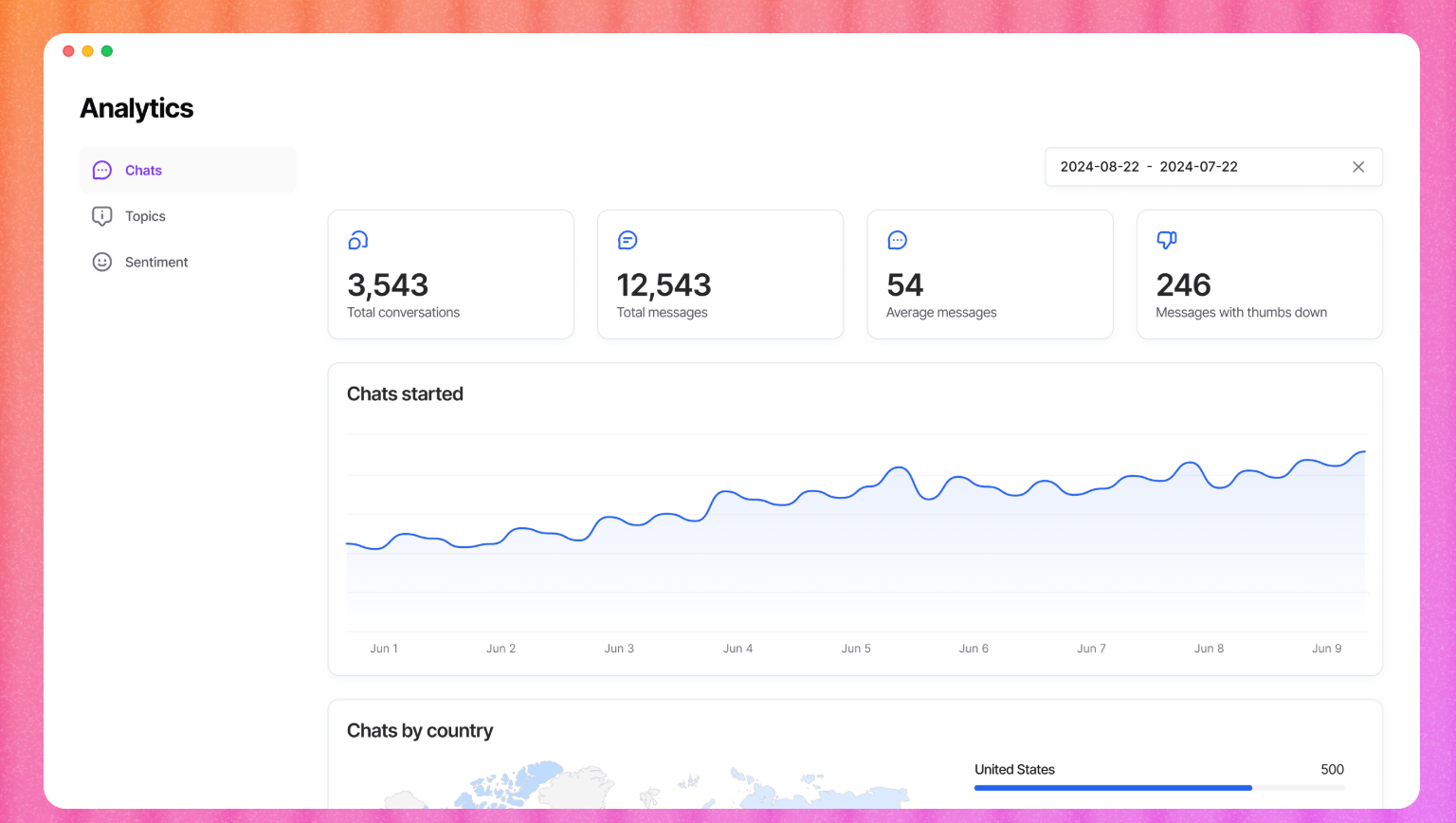
Botpress supports team collaboration and version control
Botpress is built with teams in mind. Its platform allows multiple users to collaborate on bot design, manage version history, test changes in a staging environment, and roll back updates if something goes wrong. This is a significant advantage for larger companies or agencies who prefer to treat bots as ongoing projects rather than “set and forget.” For example, you can have your content team, developers, and QA working simultaneously on different parts of the bot, dramatically speeding up iteration.
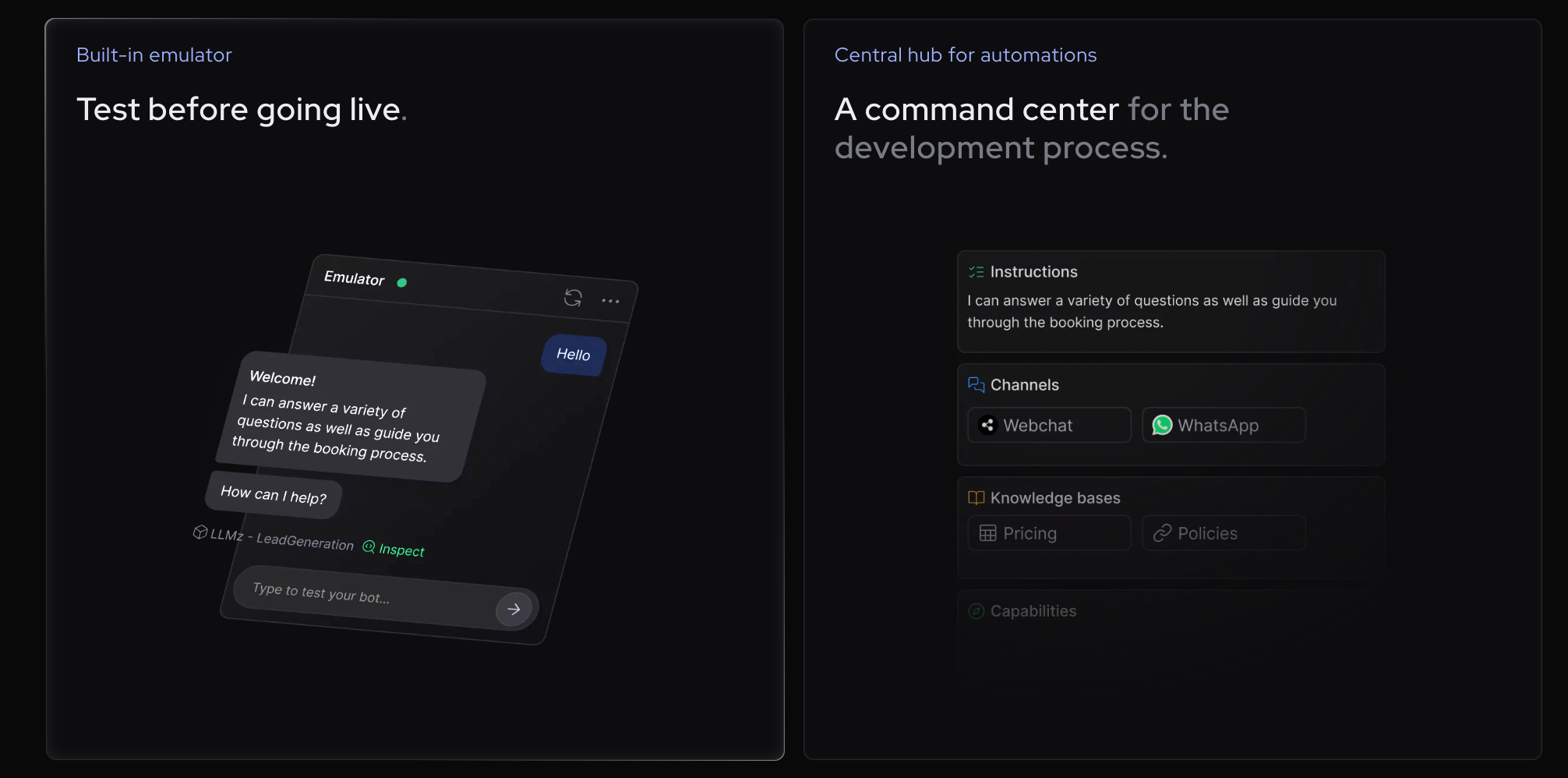
Botpress vs Chatbase: How much do they cost?
Chatbase's pricing: quick overview
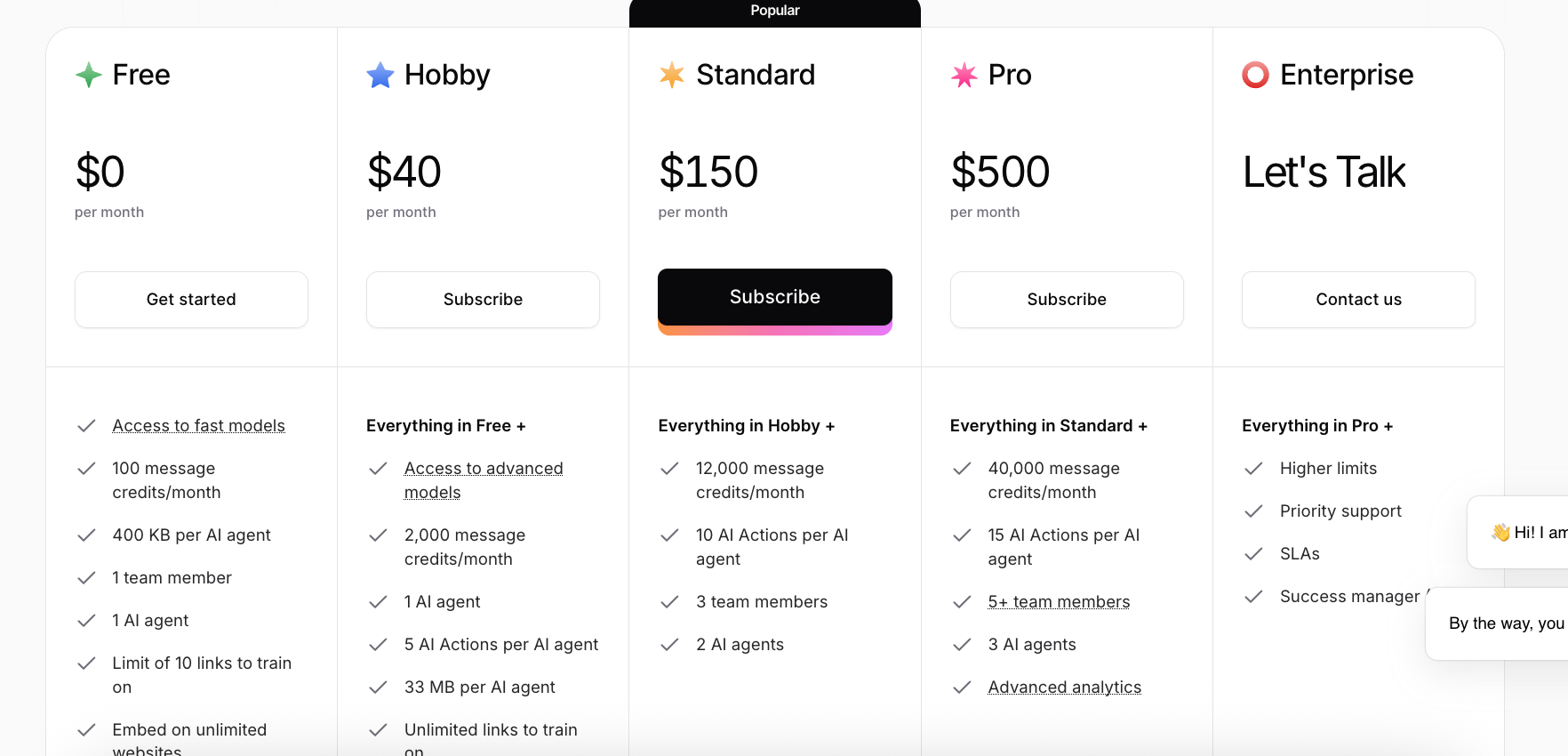
- Tier-based pricing covering usage and feature limits.
- Main plans (as of June 2024):
- Hobby: $19/month (2 bots, 2K messages/mo, 400K characters training data)
- Standard: $49/month (5 bots, 10K messages/mo, 2M characters)
- Pro: $99/month (10 bots, 40K messages/mo, 10M characters)
- Business: $399/month (50 bots, 200K messages/mo, 50M characters)
- Overage charges apply if you exceed message or data limits.
- All paid plans include custom data sources, file upload, widget customization, and basic analytics.
Botpress's pricing: quick overview
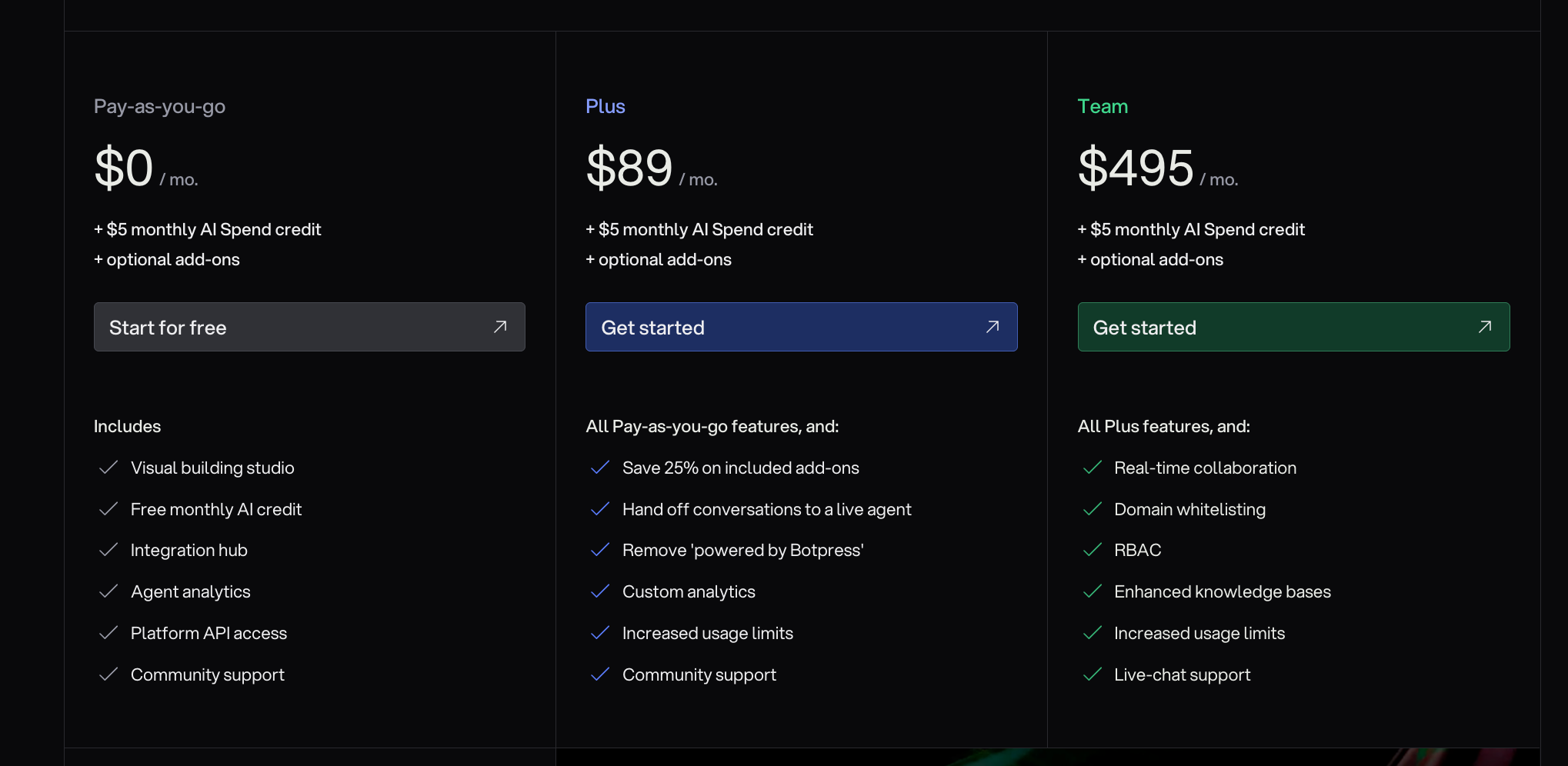
- Usage-based pricing centered on "messages" sent/received.
- Main plans (as of June 2024):
- Free: $0 (Up to 1,000 messages/month, 1 bot, Botpress Cloud branding)
- Pro: $495/month (unlimited bots, up to 50K messages/mo, team features)
- Enterprise: Custom pricing (higher limits, private hosting, advanced analytics)
- Additional charges for usage over message limits.
- Pro and Enterprise offer SSO, team management, priority support, and removal of Botpress branding.
Key differences between each pricing structure
- Chatbase uses clear volume-based plans (bots, message limits, training data).
- Botpress leans towards usage-based billing with higher starting costs for business plans, and primarily charges for messages processed.
- Botpress Pro is significantly more expensive than Chatbase's "Pro" tier but offers more team features and higher support.
- API access: Both platforms include API access based on plan, but Botpress restricts advanced integrations to higher tiers.
How does pricing increase with heavy usage?
- Chatbase increments in well-defined steps ($19 → $49 → $99 → $399) as you scale bots or volume, plus overage costs if you exceed message or character limits.
- Botpress has a steep jump from Free to Pro ($0 → $495/month), with Enterprise pricing needed for scale, and high overage fees for excess messages. Scaling past 50K messages or custom hosting requires direct sales engagement.
Other potential surprises
- Chatbase:
- Overage message charges and large jumps between plan limits.
- Training data size limits could require manual data splitting if exceeded.
- White-label/chatbot widget customization only on higher plans.
- Botpress:
- "Pro" plan is enterprise-priced and may surprise SMBs.
- Advanced team and integration features are paywalled at higher pricing.
- Free plan cannot remove "Powered by Botpress" branding, and integrations are limited.
Summary Table:
| Tool | Pricing (entry/pro/enterprise) | Free Plan | Overages | Surprises/Notes |
|---|---|---|---|---|
| Chatbase | $19/$99/$399 (per month) | No ongoing free plan (trial only) | Pay per 1K messages if limits exceeded | Jumps between plans, limits on bots and data, white-labeling for higher tiers |
| Botpress | $0/$495/Custom | 1K messages/mo, 1 bot, Botpress branding | Pay for each message over plan limit | Large leap in price to Pro, enterprise features at custom price |
Chatbase vs Botpress: Integrations & Workflows
Chatbase: Plug-and-Play Simplicity
- Integration Options: Chatbase offers quick integration with major platforms like websites, WhatsApp, Messenger, Slack, and Zapier, letting you connect bots to popular business channels in minutes.
- Embedding and APIs: Easy-to-use embed codes for websites and straightforward API keys for flexible connections.
- Workflow Management: Visual, no-code flow builder focused on straightforward question-answer bots. Automation setups are drag-and-drop, best for FAQ and lead generation scenarios.
- Third-Party Integrations: Relies heavily on Zapier for advanced workflows, enabling connections to thousands of apps, but lacks deep, native integrations for complex backend processes.
Botpress: Developer-Friendly Automation
- Integration Options: Botpress shines with its SDKs, REST APIs, and built-in connectors for platforms like Facebook, Telegram, Slack, Twilio, and Microsoft Teams.
- Custom Extension: Supports custom module developments, webhooks, middleware, and scripting, enabling robust integration with CRMs, ERPs, and proprietary enterprise systems.
- Workflow Engine: Advanced visual flow editor with support for context, memory, conditions, and multi-turn dialogues. Suitable for creating sophisticated automations, conversational workflows, and backend actions.
- Ecosystem Integrations: Marketplace for community-made modules and NLU integrations with services like Dialogflow and Rasa, widening automation possibilities beyond standard channels.
Key Takeaways
- Chatbase is ideal for teams wanting rapid, code-free deployment and integration with mainstream platforms.
- Botpress appeals to businesses needing deep custom integrations, advanced workflow logic, and the ability to handle complex internal systems.
Chatbase vs Botpress: AI Capabilities
Choosing the right AI chatbot builder means understanding how each platform leverages AI for automation, training, customization, and integration. Here’s a direct feature comparison:
| Feature | Chatbase | Botpress |
|---|---|---|
| AI Model Support | Connects to OpenAI GPT-3.5/4, Anthropic Claude, Google Gemini | Integrates GPT-3.5/4, Claude, Gemini, Cohere, custom via plugins |
| Knowledge Base Training | No-code upload (PDF, URL, text), fast custom knowledge base setup | Advanced knowledge ingestion, document parsing, search connectors, scriptable ingestion |
| AI Conversation Flow | Automatic, context-aware Q&A with basic intent detection | Multi-step flows, advanced intent recognition, visual flow editor, context variables |
| Customization | Limited to prebuilt flows and prompts | Full custom logic, dialogue management, entity extraction, code actions |
| Integrations | Basic web and API, Zapier, website widget | Native integrations (Slack, MS Teams, WhatsApp), API, custom modules, plugin marketplace |
| Self-Hosting/Enterprise AI | No | Yes (enterprise, on-prem, cloud, hybrid deployment) |
| AI Analytics | Message analytics, FAQ accuracy | Conversational analytics, custom event tracking, open telemetry |
Key Takeaways:
Chatbase: Best for fast, no-code chatbot deployment on website data; flexible AI source integration; limited flow customization.
Botpress: Designed for complex AI chatbots in enterprise or platform settings; offers deeper customization, advanced flows, and broader integration.
Use Chatbase if: You want quick setup, minimal configuration, and mainly Q&A or FAQ bots.
Use Botpress if: You need multi-step workflows, rich data ingestion, or tight integration with existing systems and channels.
Chatbase vs Botpress: How customizable are they?
Chatbase: Fast Setup, Guided Customization
Chatbase focuses on simplicity and rapid deployment. You can build chatbots by uploading documents or connecting to data sources and then setting a few rules and brand elements.
- UI Customization: Basic options for colors, fonts, and welcome messages.
- Conversational Flow: Limited to pre-set flows and question-answer formats.
- Integrations: Out-of-the-box integrations with popular platforms like WhatsApp and Messenger.
- Advanced Customization: Minimal. No direct access to code or backend customization.
Botpress: Full Flexibility and Developer Control
Botpress is designed for teams seeking granular control. It offers visual flow builders and access to underlying code.
- UI Customization: Deep customization with control over the chat widget’s appearance and behavior.
- Conversational Flow: Advanced dialog management, state tracking, and support for nested flows.
- Integrations: Broad third-party integration support, plus API access for custom connectors.
- Advanced Customization: Open-source, moddable, and scriptable—developers can extend almost everything, including natural language understanding, middleware, and analytics.
Chatbase vs Botpress reviews: What do customers say?
TL;DR:
🤖 Botpress generally has higher review scores and is favored for its flexibility, integrations, and open-source approach, making it popular with developers and enterprises.
🧩 Chatbase is praised for its ease of use and no-code setup but receives mixed feedback on customization and support. Botpress has a steeper learning curve, while Chatbase is limited in advanced functionality.
Review scores on major platforms
Chatbase:
G2: 4.3/5 ⭐
Product Hunt: 4.6/5 ⭐
Capterra: 4.5/5 ⭐
Botpress:
G2: 4.6/5 ⭐
Product Hunt: 4.9/5 ⭐
Capterra: 4.7/5 ⭐
Chatbase: The good
Customers consistently highlight Chatbase’s no-code simplicity and fast deployment:
“Building and integrating a chatbot to our website took less than 10 minutes, which is almost unheard of for most platforms.”
Many users on Reddit and Product Hunt love that it “requires zero coding background” and “has a clean, intuitive UI.” Small businesses and those getting started with AI chatbots commonly mention that Chatbase helps them “launch an AI support assistant with minimal effort.”
Chatbase: The bad
Criticism centers on limited advanced customization and lack of control, especially for more technical users:
“Not being able to easily inject complex logic or integrate with our internal APIs limits us as our business needs grow.”
A notable pain point in several lower-star reviews is inconsistent customer support responsiveness and occasional model hallucination. Some users also mention that Chatbase can struggle with multi-language or large data set use cases.
Botpress: The good
Botpress is lauded for its customization, deep integrations, and developer-friendly features:
“We chose Botpress because it gives us granular API access and integrates with Slack, Facebook Messenger, and our backend seamlessly.”
Advanced users and enterprises appreciate Botpress’ open-source foundation, flexible workflows, and NLU (Natural Language Understanding) capabilities. Power users rave in forums and G2 reviews about the “automation and advanced scripting options you just can’t get with no-code tools.”
Botpress: The bad
Steep learning curve is the most common complaint:
“Botpress is extremely powerful but not for the faint of heart; expect to spend a while learning how to unlock all its features.”
Non-technical users are often frustrated by the complexity, code-heavy setup, and limited onboarding help. Some reviews mention issues with documentation and a few bugs with cutting-edge features. Occasional comments touch on “resource consumption” and “platform performance” during scale.
Summary:
Choose Chatbase if you want an easy, quick chatbot with minimal setup and limited customization. Pick Botpress if you have technical resources and need a robust, customizable platform with enterprise-ready features, but be prepared for a steeper learning curve.
Chatbase vs Botpress: Pros and Cons for each
TL;DR → If you want rapid deployment with a user-friendly interface and solid support for RAG (retrieval-augmented generation), Chatbase is a better starting point, especially for content-driven businesses needing easy custom chatbot training.
If your priority is deep customization, complex workflows, on-premises deployment, and powerful third-party integrations,
Botpress delivers superior flexibility, though with a steeper learning curve. It is best suited for developers and enterprises needing robust logic, custom flows, API access, and private hosting; however, it requires more technical skill and has a complex setup.
| Tool | Best For | Key Strength | Drawbacks | Pricing |
|---|---|---|---|---|
| Chatbase | No-code users, SMBs, marketing sites | Super fast setup, easy data upload, white-label options | Limited advanced customization and logic, API is basic, scaling can get expensive | Hobby: Free; Standard: $19/mo; Pro: $99/mo; Business: $99+/mo |
| Botpress | Developers, enterprises, technical teams | Custom workflows, on-prem deploy, deep API & integration support | Higher learning curve, cluttered UI, slower for non-technical users | Community: Free; Pro: $495/mo; Enterprise: Custom |
The bottom line: Which tool is better for my business?
Chatbase and Botpress both offer strong AI chatbot solutions, but which is right for you depends on your business priorities. Here’s how to decide:
Choose Chatbase if you want…
Speed and Simplicity:
Chatbase is designed for non-technical users who want to launch a website chatbot in minutes with zero coding. You can upload PDFs, URLs, or text directly and get a functional, natural-sounding chatbot almost instantly. Its drag-and-drop platform and no-code editor mean anyone can build and deploy bots without a developer.
Affordable, Tiered Pricing:
Chatbase’s plans start at $19/month, making it accessible for startups and small businesses. Pricing is clear and based on the number of bots, messages, and training data — with options up to $399/month for larger operations.
Plug-and-play Integrations:
Native support for popular channels (web, WhatsApp, Messenger, Slack, Zapier) allows rapid deployment to the places your customers already are. Embedding a bot on your website is quick and easy.
Reliable Analytics and Feedback:
Built-in chatbot performance analytics and user feedback tools help you improve your bot without third-party add-ons.
Best for:
- Small to mid-sized businesses, marketing teams, and anyone needing a fast Q&A, FAQ, or onboarding bot.
- Teams with little to no technical experience.
- Projects prioritizing ease of use over custom flows or back-end connections.
Choose Botpress if you need…
Advanced Customization and Developer Control:
Botpress excels for technical teams and developers who want deep customization. You get a visual flow editor, scripting options, state management, and the ability to build complex, multi-step conversational AI that goes beyond simple Q&A.
Multichannel & Self-Hosting:
Deploy across web, mobile, messaging platforms like WhatsApp, Slack, Teams, and more. Botpress supports both cloud and self-hosting (open source/on-prem)—ideal for enterprises needing data control or custom environments.
Extensive Integrations and Workflows:
With SDKs, APIs, plugin marketplaces, and integrations for CRMs, ERPs, and more, Botpress lets you connect your chatbot to almost any system. You can automate ticketing, lead routing, and internal processes with sophisticated logic.
Enterprise-grade Collaboration & Versioning:
Multi-user project roles, granular permissions, and built-in version control make Botpress well-suited for larger organizations and agencies handling ongoing, mission-critical automation projects.
Flexible AI Model Support:
Integrates with a wider range of AI providers (OpenAI, Google, Anthropic, Cohere, custom models), along with powerful NLU and workflow capabilities for highly conversational and context-aware bots.
If you want to learn more about AI chatbot platforms and automation, check out these guides from Big Sur AI:
- The Best AI Customer Support Tools: What Top Platforms Offer in 2024
- How Retrieval-Augmented Generation (RAG) is Changing Chatbots
- Top No-Code AI Tools for SMBs: What to Try in 2024
Ready to build smarter chatbots? Give Big Sur AI a try and start automating your business today!

